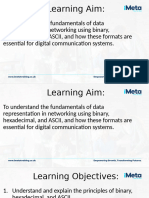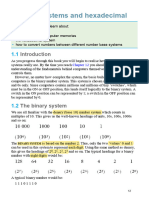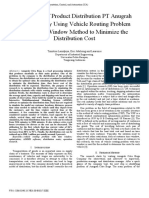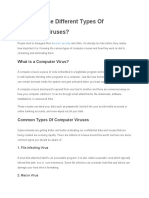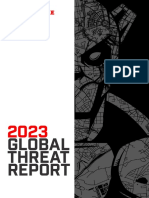Binary
Uploaded by
api-417400228Binary
Uploaded by
api-417400228Binary and conversions
Data – Raw material, words/numbers without a meaning or purpose
Information – the raw data is used and put into some context
Knowledge – Is the understanding taken from the information gathered
Binary/ denary/ hexadecimal
Binary - It is a 'base-2' number system - This type of number will only have two
digits, a 1 or 0 and is used to represent the two states (ON, OFF) of a computer
whilst processing data. The digital data that is known as bits and bytes can also
be represented as a binary number.
128 64 32 16 8 4 2 1
0 1 0 0 1 0 1 1
Bit - (This is a single binary digit), each bit is represented as a 1 or 0 and is the
smallest unit of data that can be stored.
Byte - A byte contains 8 bits, e.g. 10000101. A single character on the keyboard
is equivalent to one byte.
Denary – It is a ‘base-10’ number system. This has the number digits
0,1,2,3,4,5,6,7,8 and 9 and is used by humans.
1000-103 100-102 10-101 10-100
4 thousand 3 hundred 7 seventy 5
Hexadecimal – Is a ‘base-16’ number system. There are 16 values; the
decimal numbers from 10 to 15 are represented with the letters A to F.
Converting Binary to Denary
Binary 128 64 32 16 8 4 2 1 Denary equivalent
1011010 1 0 1 1 0 1 0 1 128+32+16+4+1=18
1 1
0010111 0 0 1 0 1 1 1 1 32+8+4+2+1=47
1
1100101 1 1 0 0 1 0 1 1 128+64+8+2+1=263
1
0001001 0 0 0 1 0 0 1 1 16+2+1=19
1
Converting Denary to Binary
Numbe 128 64 32 16 8 4 2 1 Binary
r equivalen
t
115 0 1 1 1 0 0 1 1 01110011
255 1 1 1 1 1 1 1 1 11111111
59 0 0 1 1 1 0 1 1 00111011
131 1 0 0 0 0 0 1 1 10000011
Representing Text
To make the passing of data from one computer to another easy, a standard
form of representing characters was adopted by computer manufacturers. The
American Code for Information Interchange (ASCII).
You might also like
- M800-M80-E80 Series Maintenance Manual Ib1501273enghNo ratings yetM800-M80-E80 Series Maintenance Manual Ib1501273engh224 pages
- Worksheet on Number System, Data Compression, Transmission and HardwareNo ratings yetWorksheet on Number System, Data Compression, Transmission and Hardware6 pages
- Section 1 - Information Representation and Multimedia - 1.1.1 To 1.1.5-1No ratings yetSection 1 - Information Representation and Multimedia - 1.1.1 To 1.1.5-110 pages
- CIE IGCSE Computer Science: 1.1 Number SystemsNo ratings yetCIE IGCSE Computer Science: 1.1 Number Systems16 pages
- Paper I Unit 1.4.1: Data RepresentationNo ratings yetPaper I Unit 1.4.1: Data Representation22 pages
- Data Representation (No Sound or Images)No ratings yetData Representation (No Sound or Images)3 pages
- G8 - Unit 9 - Data - Data Representation - Part ANo ratings yetG8 - Unit 9 - Data - Data Representation - Part A11 pages
- A'Level_Computer_Science_by_Zafar_Ali_KhanNo ratings yetA'Level_Computer_Science_by_Zafar_Ali_Khan172 pages
- Lesson2 - Data Representation - HexadecimalNo ratings yetLesson2 - Data Representation - Hexadecimal12 pages
- Logic Circuits: 1. Logon To The Logic Gate Simulator WebsiteNo ratings yetLogic Circuits: 1. Logon To The Logic Gate Simulator Website7 pages
- Avanade - Windows Server 2003 Case StudyNo ratings yetAvanade - Windows Server 2003 Case Study5 pages
- 4.6.6.5_Lab___Using_Wireshark_to_Examine_HTTP_and_HTTPSNo ratings yet4.6.6.5_Lab___Using_Wireshark_to_Examine_HTTP_and_HTTPS4 pages
- Simulation of Product Distribution PT Anugrah Citra Boga by Using Vehicle Routing Problem With Time Window Method To Minimize The Distribution CostNo ratings yetSimulation of Product Distribution PT Anugrah Citra Boga by Using Vehicle Routing Problem With Time Window Method To Minimize The Distribution Cost4 pages
- IoT Sec 1.1 Fundamentals - IoT Security Final Exam AnswersNo ratings yetIoT Sec 1.1 Fundamentals - IoT Security Final Exam Answers29 pages
- There Is No Such Thing As A Microservice!: Chris RichardsonNo ratings yetThere Is No Such Thing As A Microservice!: Chris Richardson71 pages
- Vol.d1 Maintenance & Repair Manual of Wag-9No ratings yetVol.d1 Maintenance & Repair Manual of Wag-9593 pages
- SIR Seymur Akbarov StructuralDetailedDesign 20181107 133427No ratings yetSIR Seymur Akbarov StructuralDetailedDesign 20181107 1334276 pages




